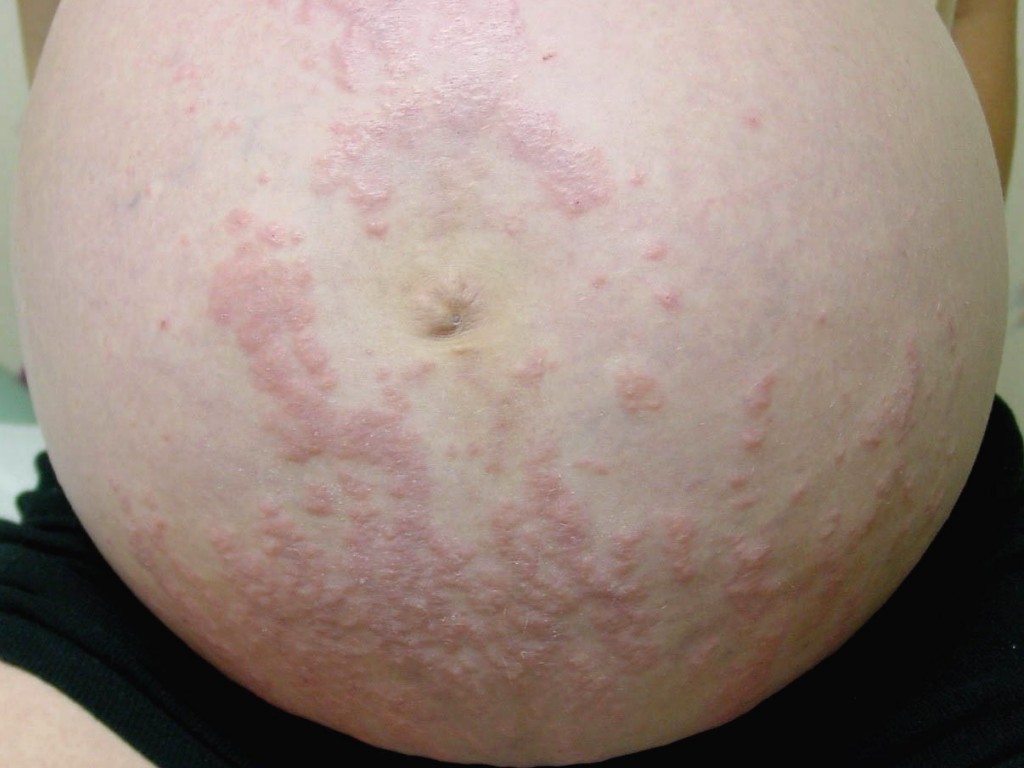What are the symptoms of PUPPP rash?
PUPPP rash, or Pruritic Urticarial Papules and Plaques of Pregnancy, is a condition that typically occurs in the third trimester of pregnancy. The symptoms include:
- Intense Itching: Severe itching is the most prominent symptom and can be very uncomfortable.
- Red, Raised Rash: The rash often appears as red or pink bumps and welts on the skin. It usually starts on the abdomen and may spread to other areas, such as the thighs, buttocks, and sometimes the arms.
- Rash Pattern: The rash commonly starts in the stretch marks on the abdomen and can progress to involve the surrounding skin, forming plaques.
- Skin Lesions: The rash consists of papules (small, raised bumps) and plaques (larger, flat areas). These lesions can be itchy and may coalesce into larger areas.
- Abdominal Itching: The rash frequently starts around the belly and may be particularly noticeable in areas where the skin is stretched, such as the abdomen and sides.
- Exclusion of Other Conditions: PUPPP typically does not affect the face, palms, or soles, and is distinguished from other pregnancy-related rashes by its location and appearance.
PUPPP is generally not harmful to the mother or the baby, but it can be very uncomfortable. Management usually includes topical treatments like corticosteroids and antihistamines to relieve itching and inflammation.
What are the causes of PUPPP rash?
The exact cause of PUPPP (Pruritic Urticarial Papules and Plaques of Pregnancy) rash is not fully understood, but several factors are believed to contribute to its development:
- Stretching of the Skin: The most widely accepted theory is that PUPPP is related to the stretching of the skin during pregnancy, especially in the abdominal area. As the skin stretches to accommodate the growing uterus, it may trigger the rash.
- Hormonal Changes: Hormonal fluctuations during pregnancy may play a role in the development of PUPPP. The increase in certain hormones may affect the skin’s response and contribute to the rash.
- Genetic Factors: There may be a genetic predisposition to PUPPP, as the condition can occasionally run in families. A family history of similar rashes may increase the risk.
- Immune System Response: An altered immune system response during pregnancy may contribute to the development of PUPPP. The rash might be related to changes in how the body reacts to environmental or internal factors.
- Multiple Pregnancies: PUPPP is more commonly seen in women who are carrying multiple babies (twins or more), which leads to greater skin stretching.
- Preexisting Conditions: In some cases, PUPPP may occur in conjunction with other pregnancy-related conditions, such as preeclampsia or gestational diabetes, although it is not directly caused by these conditions.
Despite these theories, PUPPP rash is generally considered a benign condition that resolves after childbirth. It is important for affected individuals to seek medical advice to ensure proper diagnosis and management of the rash.
What is the treatment for PUPPP rash?
The treatment for PUPPP (Pruritic Urticarial Papules and Plaques of Pregnancy) focuses on relieving symptoms and managing discomfort. Here are common treatment options:
- Topical Corticosteroids: Prescription or over-the-counter corticosteroid creams or ointments can reduce inflammation and itching. They are applied directly to the affected areas of the skin.
- Antihistamines: Oral antihistamines, such as cetirizine or loratadine, can help alleviate itching and discomfort. Consult with a healthcare provider to choose an appropriate antihistamine during pregnancy.
- Moisturizers: Regular use of emollients and moisturizers can help soothe the skin and prevent dryness, which can exacerbate itching.
- Cool Compresses: Applying cool, damp cloths to the affected areas can provide temporary relief from itching and discomfort.
- Oatmeal Baths: Taking baths with colloidal oatmeal can help soothe itchy skin and provide relief.
- Avoiding Irritants: Wearing loose, breathable clothing and avoiding harsh soaps or skin care products can help prevent irritation and reduce symptoms.
- Maintaining a Healthy Skin Care Routine: Keeping the skin clean and moisturized can help manage symptoms and prevent further irritation.
- Monitoring for Complications: While PUPPP is generally benign and resolves after childbirth, monitoring for any changes or worsening of symptoms is important. If the rash is accompanied by other symptoms or if there are concerns about the severity, consult a healthcare provider.
Most cases of PUPPP resolve on their own after delivery. Treatment aims to manage symptoms until the rash naturally subsides. Always consult with a healthcare provider before starting any new treatment or medication during pregnancy.

Leave a Reply
You must be logged in to post a comment.